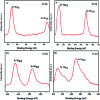CuZn2InTe4 quantum dots-a novel nanostructure employing a green synthesis route
- PMID: 35518340
- PMCID: PMC9053954
- DOI: 10.1039/d0ra02980g
CuZn2InTe4 quantum dots-a novel nanostructure employing a green synthesis route
Abstract
We report the synthesis and characterisation of novel CuZn2InTe4 quantum dots (QDs) suitable for various optoelectronic applications. The nanostructures grown are technologically important due to their Cd and Pb-free composition. The synthesis was maintained "green" by using a phosphine free organometallic procedure utilizing octadecene as the coordinating solvent. The structural properties of the nanocrystals (NCs) were analyzed using high resolution transmission electron microscopy (HRTEM), selected area electron diffraction (SAED) and X-ray diffraction (XRD). The composition was verified using X-ray photoelectron spectroscopy (XPS), inductive coupled plasma-optical emission spectroscopy (ICP-OES) and energy dispersive X-ray spectroscopy (EDX). The optical studies were performed using UV-VIS-NIR spectroscopy and photoluminescence (PL) spectroscopy and the band gap value obtained was verified using cyclic voltammetry (CV). The nanostructures grown were spherical with a size of about 5 nm possessing appreciable monodispersity.
This journal is © The Royal Society of Chemistry.
Conflict of interest statement
There are no conflicts to declare.
Figures
Similar articles
-
CuInS2-In2Se3 quantum dots - a novel material via a green synthesis approach.RSC Adv. 2018 Nov 5;8(65):37146-37150. doi: 10.1039/c8ra07389a. eCollection 2018 Nov 1. RSC Adv. 2018. PMID: 35557798 Free PMC article.
-
Composition-Tunable Optical Properties of Zn x Cd(1 - x)S Quantum Dot-Carboxymethylcellulose Conjugates: Towards One-Pot Green Synthesis of Multifunctional Nanoplatforms for Biomedical and Environmental Applications.Nanoscale Res Lett. 2017 Dec;12(1):443. doi: 10.1186/s11671-017-2212-8. Epub 2017 Jul 5. Nanoscale Res Lett. 2017. PMID: 28683540 Free PMC article.
-
Photoinduced electron transfer in novel CdSe-Cu2Se type II core-shell quantum dots.RSC Adv. 2019 May 14;9(26):15092-15098. doi: 10.1039/c9ra02027f. eCollection 2019 May 9. RSC Adv. 2019. PMID: 35516312 Free PMC article.
-
Intracellular biosynthesis of PbS quantum dots using Pseudomonas aeruginosa ATCC 27853: evaluation of antibacterial effects and DNA cleavage activities.World J Microbiol Biotechnol. 2020 Sep 5;36(10):147. doi: 10.1007/s11274-020-02917-z. World J Microbiol Biotechnol. 2020. PMID: 32888099
-
Instrumental Techniques for Characterization of Molybdenum Disulphide Nanostructures.J Anal Methods Chem. 2020 Dec 16;2020:8896698. doi: 10.1155/2020/8896698. eCollection 2020. J Anal Methods Chem. 2020. PMID: 33381353 Free PMC article. Review.
Cited by
-
Colloidal Cu-Zn-Sn-Te Nanocrystals: Aqueous Synthesis and Raman Spectroscopy Study.Nanomaterials (Basel). 2021 Oct 31;11(11):2923. doi: 10.3390/nano11112923. Nanomaterials (Basel). 2021. PMID: 34835686 Free PMC article.
References
-
- Zhang W. Lou Q. Ji W. Zhao J. Zhong X. Chem. Mater. 2014;26:1204–1212. doi: 10.1021/cm403584a. - DOI
LinkOut - more resources
Full Text Sources
Miscellaneous






